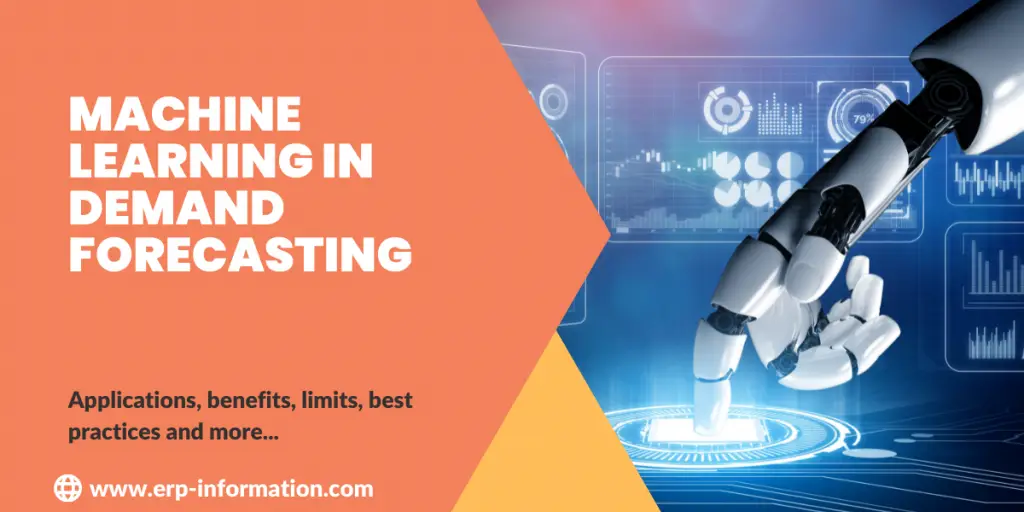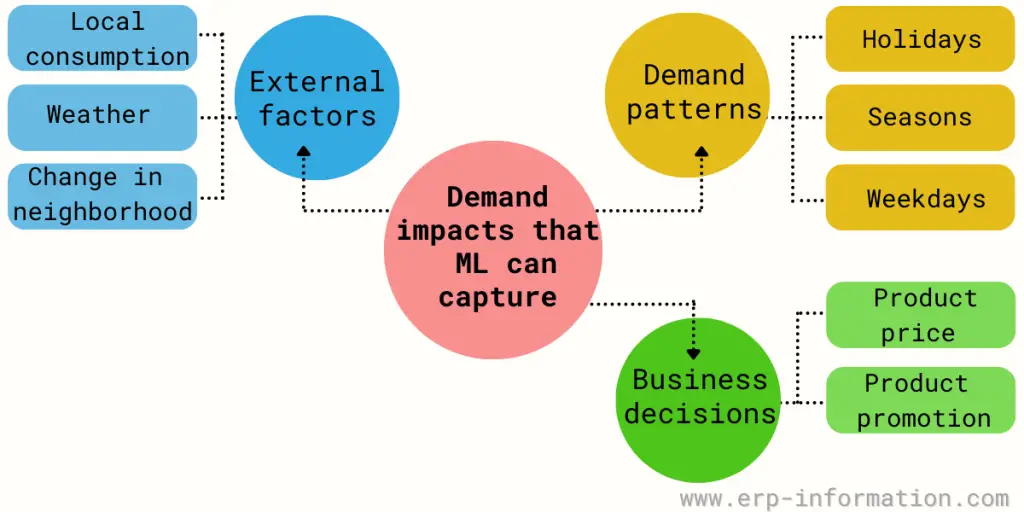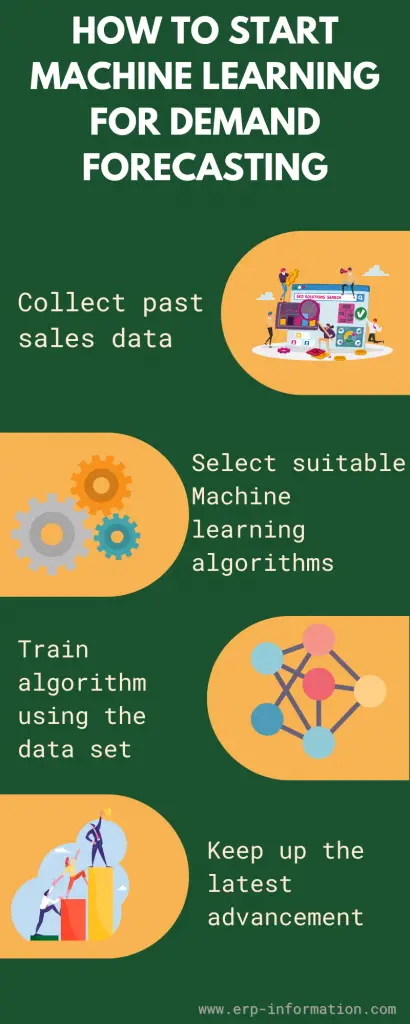Accurately predicting customer demand has become more crucial than ever for businesses. Traditional forecasting methods often fall short, relying on static data and outdated models. This is where machine learning comes in—a revolutionary approach to demand forecasting.
Machine learning enables businesses to make precise, data-driven predictions about future demand by leveraging advanced algorithms and vast amounts of historical data.
The article will discuss machine learning in demand forecasting, its benefits, limits, best practices, and also real-world applications.
What is Machine Learning (ML)?
It is a subsection of artificial intelligence that analyzes data to learn from it and make predictions or decisions.
Machine learning algorithms can be used to understand and improve from experience automatically. That makes them very effective in demand forecasting, which can be used to predict future demand trends based on past data.
What is demand forecasting?
Demand forecasting predicts how much of a particular product or service customers will demand over a specific period. Demand forecasting is an important part of business supply planning.
It helps businesses make informed decisions about production, inventory levels, marketing strategies, financial planning, and other aspects that depend on customer demand.
Why is machine learning so effective in demand forecasting?
Machine learning is effective in demand forecasting because it can learn from past data to predict future demand trends. It makes it very accurate and efficient at forecasting demands. This means
- You can avoid some of the traditional problems with planning, like long wait times, high transport costs, too much inventory, and bad decisions because of inaccurate forecasts.
- Machine learning models help us improve forecast accuracy and free up planners’ time so they can focus on more important products or gather more information at the last minute.
Our list of online calculators helps you to do demand forecasting
Applications of machine learning in demand forecasting
Some real-world applications of machine learning in demand forecasting include:
- Predicting consumer demand for new products
- Forecasting sales for retail businesses
- Forecasting energy demand
- Predicting demand for transportation services
We will discuss each of these applications in more detail below.
Predicting consumer demand for new products
Machine learning can be used to predict consumer demand for new products. For example, You can use machine learning to analyze past sales data and identify patterns that may indicate how consumers will respond to a new product.
This information can then be used to forecast future sales of the product.
Forecasting sales for retail businesses
Machine learning is helpful for forecasting sales for retail businesses. Retail businesses generate many data, such as point-of-sale data, that can be used to train machine learning models.
You can use these models to predict future sales based on historical sales data, weather conditions, and holidays.
Forecasting energy demand
You can utilize ML to analyze past energy consumption data and identify patterns that may indicate how energy demand will change. So you can use this information to forecast future energy demand.
Predicting demand for transportation services
To predict demand for transportation services, you can use machine learning. For example, it helps to analyze past data on taxi rides and identify patterns that may indicate how demand for taxi services will change.
That information can then be used to forecast future demand for taxi services.
Demand impacts that ML can capture
- Demand patterns: ML captures variations in demands based on seasons, weekdays, and holidays
- Business decisions: Changing product prices and promotion of products also impact on DEMAND that ML will collect
- External factors: Weather and local consumption of the product will affect demand.
Benefits
There are many benefits to using machine learning for demand forecasting, including the following:
- Speed processing of data – Machine learning collects data automatically. Hence you will get all the data very quickly.
- Increased accuracy – Machine learning can accurately predict demand patterns based on past data, which can help businesses more accurately forecast future needs and better allocate resources.
- Reduced costs – Machine learning can help reduce the number of wasted resources due to over or under-stocking, which leads to significant savings for businesses.
- Improved decision-making – By providing accurate forecasts, machine learning can help businesses make better inventory levels, pricing, production planning, and more decisions. That helps companies stay competitive and improve their bottom line.
How to get started with Machine Learning for demand forecasting?
Here are a few things you need to do to get started with machine learning for demand forecasting.
Collect past sales data
First, you need to gather data on past sales. This data can train machine learning models to predict future demand. You can then use these models to help inform your business decisions about inventory and production planning.
Select suitable machine learning algorithms
There are several different machine learning algorithms that you can use for demand forecasting. Some of the most popular include linear regression, logistic regression, and support vector machines.
You can also use machine learning algorithms like neural networks and deep learning for more complex forecasting tasks.
Train algorithm using the data set
Once you’ve selected a machine learning algorithm, you must train it using your data set. That involves feeding the algorithm examples of past data and telling it what pattern to look for. The algorithm will then use this information to predict future demand.
Keep up the latest advancement
It’s important to note that machine learning is constantly evolving, and the techniques that work the best today may not work tomorrow. So it’s essential to keep up with the latest advancements to stay ahead of the competition.
Machine learning in demand forecasting is an essential tool for any business owner. So get started today and see the benefits for yourself!
Different machine learning algorithms
You can use many different machine learning algorithms for demand forecasting. The most popular methods include regression analysis, decision trees, and neural networks.
Each method has its strengths and weaknesses, so it is crucial to choose the suitable algorithm for the problem.
Limits of machine learning in demand forecasting
Machine learning can be very beneficial to a business in demand forecasting, but there are some limits to its abilities.
- First, machine learning is only as good as the data it has been trained on. If the data set is not large or varied enough, the machine learning model may not be able to identify all the patterns in the data. That could lead to inaccurate predictions. The machine learning algorithm will not produce accurate results if the data is inaccurate or incomplete.
- Second, machine learning models can be very sensitive to changes in the data. Therefore, the machine learning model may not produce accurate predictions if the data set is updated or changed.
- Third, machine learning models can be expensive to build and maintain. Training a machine learning model can be time-consuming and require many resources. And once the model is created, it needs to be constantly monitored and updated to remain accurate.
Best practices of machine learning in demand forecasting
Businesses should remember a few best practices when using machine learning for demand forecasting.
Select the suitable ML algorithm
First, selecting the suitable machine learning algorithm for the problem at hand is essential.
Each machine learning algorithm has its strengths and weaknesses, so it is crucial to choose the algorithm that will work best for the specific data set and problem.
Evaluate machine learning model results
Second, it is crucial to evaluate the machine learning model results carefully. The machine learning model should be tested against a data set entirely separate from the data set used to train the model.
That will help to ensure that the machine learning model is accurate.
Monitor machine learning model
Third, continuously updating and monitoring the machine learning model is important. The machine learning model should be updated regularly to reflect changes in the data set. And if there are any errors in the machine learning model, they should be corrected immediately.
Ready to adjust forecasts
Finally, it is essential to remember that machine learning is not a silver bullet. No machine learning algorithm is perfect, so businesses should always be prepared to adjust their forecasts if necessary.
Best Machine learning software for Demand forecasting
Below is the list of demand forecasting machine learning software that facilitates your business.
- Minitab
- Statgraphics Centurion
- Google Cloud BigQuery
- Prime AI
- Valohai
- Intersect Labs
- Neuton AutoML
- TADA
- SAS Customer Intelligence 360
- OpenText Magellan
FAQs
Which machine learning model is used for demand forecasting?
For accurate forecasting, LSTM and ANN models are used. LSTM models can provide much more precise predictions than ANN alone. To ensure maximum benefit from this powerful tool, the training set must include 24 inputs to accurately forecast next month’s output.
Conclusion
Integrating machine learning into demand forecasting is a transformative step for businesses aiming to stay ahead in a competitive market.
By leveraging sophisticated algorithms and historical data, companies can achieve unprecedented accuracy in their forecasts, leading to better inventory management, cost savings, and improved overall efficiency.
While there are challenges and limitations to consider, the benefits far outweigh the drawbacks, making machine learning an essential tool for modern businesses.
We hope you find this article helpful.


